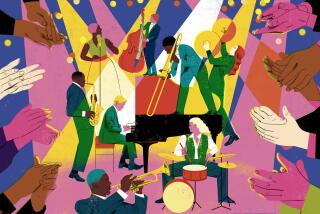What’s All This Detroit Noise?
- Share via
Critics dig ‘em, and fans are catching on to the White Stripes, the Motor City boy-girl duo whose growing popularity is making the concept of the “Detroit sound” synonymous with its raw, folk-garage-blues.
“White Blood Cells,” the band’s third release on the Long Beach label Sympathy for the Record Industry, finished No. 4 on the Village Voice’s influential critics’ poll this year, and the duo sold out four dates at New York’s Bowery Ballroom in an hour. It has even been popping up on KROQ amid all the aggro crunch-rock, and the band recently signed a deal with BMG affiliate V2 Records.
The Motor City is a fertile ground for groups that share at least a glancing kinship with the Stripes’ sound, a minimal yet flexible style that can evoke the Velvet Underground, the Cramps, the Who and Eels while remaining its own animal. Among the most prominent are soul-rockers the Detroit Cobras and eclectic punk-R&B-popsters; the Dirtbombs, both of whom can be heard on “The Sympathetic Sounds of Detroit,” a compilation album produced by Stripes singer-guitarist Jack White.
So is this a phenomenon in the making? Will the attention given the White Stripes bring a flood of Detroit bands into the mainstream, a la Nirvana and Seattle a decade ago?
The natives do seem to have noticed an increasing number of looky-loos popping up in Detroit to see what’s what. But as Detroit Cobras singer Rachael Nagy puts it, “It’s laughable, because there’s not one sound. It’s not like Seattle.”
Nagy sees only a general similarity among some acts. “What everyone’s calling the Detroit sound right now is just true-to-form dirty garage,” she says. “It’s raw, and that’s as close as you can tag it, but it’s not really a sound. It’s just dirty.”
The current grass-roots Detroit acts come in a dazzling variety pack of styles, from the aforementioned soul- and proto-punk-influenced groups to Meatmen-style rude punk (the Clone Defects), shoe-gazers (Slumber Party) and pop of all stripes (the Waxwings, the Sights, Outrageous Cherry, Volebeats). And this is just a drop in the bucket.
“No two bands in Detroit sound even vaguely close to each other,” contends Pat Pantano, one of the Dirtbombs’ two drummers. A photographer who has shot the White Stripes and many other groups, Pantano illustrates his point with an anecdote about one of the scene’s few common threads--Ghetto Recorders, the studio owned by Dirtbombs bassist Jim Diamond where many bands cut their singles and albums.
“I went there one day, and in the studio was the Clone Defects, who sound sort of like the Dead Boys,” Pantano says. “A few days later I had to go back, and at that point it was Slumber Party, which is four girls who do this sort of ethereal, almost silent music with a lot of harmonies.
“There’s not a high school diploma among the lot of the Clone Defects, and the singer for Slumber Party has a PhD in microbiology, but that night I went to the bar, and they were all drinking together. It’s just that kind of world.” He shrugs. “And that’s why it’s hard [for outsiders] to pinpoint it.”
Sympathy for the Record Industry owner Long Gone John, who has a long association with Detroit acts, isn’t sure there are so many more stellar acts in the Motor City than elsewhere. “But Jack [White] really loves to wave the Detroit flag and pull other people along with him,” says the indie mogul, who released the “Sympathetic Sounds” anthology last year.
The White Stripes represent his label’s greatest success, but he has released other personal Detroit favorites as well, including the Cobras, the Come Ons and the Von Bondies, whose 2001 debut, “Lack of Communication,” was produced by White.
Given the Motor City’s history, the diversity only makes sense. Indeed, over the decades the phrase “Detroit sound” has been applied to numerous seminal styles, including the proto-punk of the Stooges and the MC5, the legendary soul of Motown Records, the R&B-rock; of Mitch Ryder and the pioneering techno acts of the late 20th century--not to mention Eminem and Kid Rock.
What ties this loose amalgamation of acts together is an appreciation for music that has stood the test of time and a pursuit of excellence that can’t be measured by record sales or even popularity. This is fueled in part by demographics--not just the racial mix that helped foster the historical diversity of sound in the first place, but also the city’s ghost-town quality.
“It’s a big city that’s become half the [population] size it was,” says Jim Ransweiler, who grew up in Detroit and now lives in L.A. He runs the indie punk label Scooch Pooch Records, which released a Cobras single in 1996 and plans a retrospective of virtually unknown ‘70s Detroit punk band the Sillies for later this year.
“It’s an empty place,” Ransweiler says. “There’s not enough people to support a hundred different scenes, like here in L.A. So everybody supports everybody else. And [the setting] does create a mind-set. There’s a lot of vacant buildings and things that sit there rotting.”
One common characterization of Detroit bands, many say, is that they don’t tend to dream of making it big. Groups get together, notes Dirtbombs guitarist Tom Potter, because there’s not a lot to do. Even the non-musically inclined Detroiter can’t help noting the richness of the city’s legacy, and musicians tend to be more obsessive there, adds the group’s singer-guitarist, Mick Collins.
This combination of isolation and knowledge fosters an insular yet freer environment, in which the individuality of the White Stripes, for example, is encouraged and celebrated rather than ridiculed for not being commercial, as they might be in New York or Los Angeles, where bands are more inclined to focus on making it.
If it turns out that major labels don’t find much to keep them in Detroit for more than a night or two, perhaps the spotlight on the White Stripes will spark some curiosity among listeners about what else the Motor City has to offer in a pop climate that seems to be slowly turning away from slick teen pop and glib angst-mongers.
“I think the Detroit Cobras could have a wider [audience], absolutely,” says Long Gone John. “They’re not freaky or weird, they don’t alienate people. If more people could see them, why wouldn’t they like them? They’re a great rock ‘n’ roll band.”
*
Natalie Nichols is a regular contributor to Calendar.
More to Read
The biggest entertainment stories
Get our big stories about Hollywood, film, television, music, arts, culture and more right in your inbox as soon as they publish.
You may occasionally receive promotional content from the Los Angeles Times.










